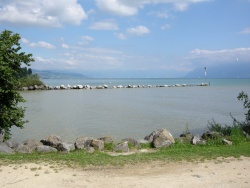Overview
This small location lies at the northern shore of the Lake of Geneva. Despite its size it's an important stop over for passage migrants and a hotspot for rarities in Switzerland.
Birds
Notable Species
Wintering waterfowl including Red-throated Diver, Red-necked Grebe, other Grebes, several species of Duck, including Long-tailed Duck. Migrating waders in spring and autumn, including Eurasian Oystercatcher, Black-winged Stilt, Pied Avocet, Kentish Plover, Grey Plover, Ruddy Turnstone, Bar-tailed Godwit and many more. Mediterranean Gull is regular, Little Gull, Black Tern, White-winged Black Tern and Whiskered Tern also. Also raptors and passerines pass over this spot.
Rarities
An impressive list, including Lesser Spotted Eagle, Pacific Golden Plover and Slender-billed Gull. Most rarities turn up in April, May, September or October.
Check-list
Birds you can see here include:
Red-throated Diver, Black-throated Diver, Great Northern Diver, (rare), Great Crested Grebe, Little Grebe, Black-necked Grebe, Red-necked Grebe, Slavonian Grebe, Great Cormorant, Black-crowned Night Heron, Little Egret, Great White Egret, Grey Heron, Black Stork, White Stork, Mute Swan, Common Shelduck, Eurasian Wigeon, Mallard, Gadwall, Northern Pintail, Northern Shoveler, Common Teal, Garganey, Red-crested Pochard, Common Pochard, Tufted Duck, Greater Scaup, Common Goldeneye, Long-tailed Duck, Velvet Scoter, Common Scoter (rare), Goosander, Smew, Red-breasted Merganser, Black Kite, Red Kite (rare on passage), Western Marsh Harrier, Eurasian Sparrowhawk, Eurasian Goshawk, European Honey Buzzard, Common Buzzard, Osprey, Eurasian Hobby, Common Kestrel, Common Moorhen, Common Coot, Eurasian Oystercatcher, Black-winged Stilt, Pied Avocet,Ringed Plover, Little Ringed Plover, Kentish Plover, Northern Lapwing, Grey Plover, Ruddy Turnstone, Sanderling, Red Knot, Curlew Sandpiper, Dunlin, Little Stint, Temminck's Stint, Ruff, Eurasian Curlew, Whimbrel, Black-tailed Godwit, Bar-tailed Godwit, Common Redshank, Spotted Redshank, Common Greenshank, Wood Sandpiper, Common Sandpiper, Green Sandpiper, Common Snipe, Mediterranean Gull, Black-headed Gull, Common Gull, Yellow-legged Gull,Lesser Black-backed Gull, Common Tern, Caspian Tern, Black Tern, White-winged Black Tern, Whiskered Tern, Sandwich Tern, Common Woodpigeon, European Turtle Dove, Eurasian Collared Dove, Common Cuckoo, Alpine Swift, Common Swift, Common Kingfisher, Great Spotted Woodpecker, Sand Martin, Barn Swallow, Northern House Martin, Water Pipit, Meadow Pipit, Red-throated Pipit, White Wagtail, Grey Wagtail, Yellow Wagtail, Eurasian Wren, Dunnock, European Robin, Common Nightingale, Common Redstart, Black Redstart, Northern Wheatear, Eurasian Blackbird, Song Thrush, Common Reed Warbler, Garden Warbler, Lesser Whitethroat, Blackcap, Willow Warbler, Common Chiffchaff, European Pied Flycatcher, Spotted Flycatcher, Blue Tit, Great Tit, Coal Tit, Long-tailed Tit, Eurasian Nuthatch, Short-toed Treecreeper, Common Starling, Eurasian Golden Oriole, Common Jay, Common Magpie, Carrion Crow, Eurasian Tree Sparrow, House Sparrow, Chaffinch, European Serin, European Greenfinch, European Goldfinch, Eurasian Bullfinch, Eurasian Linnet, Ortolan Bunting, Yellowhammer, Reed Bunting
Other Wildlife
In the woods nearby Squirrels can be seen and several species of Lizards live here.
Site Information
History and Use
Préverenges lies on a migration route and was therefore always a good place for birdwatching. Every four years the level of the lake is lowered, creating ideal conditions for waders. In 2002 an artificial island was created in order to protect the birds from human disturbance. Since then, the place is even more famous, especially for rare waders, terns and gulls.
It's a very popular place, especially in summer. People go swimming and walk along the shore. Early mornings are good, but waders and terns can also be seen in the afternoon.
Areas of Interest
The island itself is very interesting and can be easily watched from the shore. The lake between Morges and Préverenges is also interesting, especially in winter. It's worthwile to walk from Morges to Préverenges then (1 hour). Just west of the island, the River Venoge joins the lake. Here terns can be seen hunting. If you cross the river there is a small forest, holding Common Nightingales and Eurasian Golden Oriole.
Access and Facilities
Next bus stop is Venoge (also called St. Sulpice VD, Venoge). It can be reached with bus 57 from Morges (near the railway station) or from the EPFL Lausanne. The EPFL itself is reached by train from Lausanne Flon. From the bus stop follow the road to the west, direction Morges. Take the first road left, which leads you along the Venoge to the lake. Cross the Venoge westwards and you will reach the island very soon.
With the car take the cantonal road from Morges to Lausanne. Follow the signs Préverenges Plage and park your car at the shore. Follow the shore for about 10 minutes to the east and you reach the island.
There are some restaurants at the shore, but they are closed in winter. Accomodation is plentiful in Morges, Lausanne or St. Sulpice.





